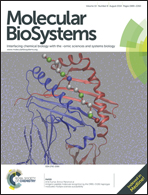Design of gliadin peptide analogues with low affinity for the celiac disease associated HLA–DQ2 protein†
Abstract
The HLA–DQ2.5 receptors bind gluten-derived peptides and present them to the T cells in the intestinal mucosa thus inducing the development of immune responses typical of the celiac disease. On the basis of the X-ray structure of the domain of HLA–DQ2.5 bound to the DQ2.5-glia-α1a epitope, fifteen peptides were designed with the aim of lowering the epitope binding affinity, thus reducing the autoimmune response. Hydroxylation of Pro residues was proposed as a suitable functionalization given that both enzymatic and chemical synthetic methods are available. Then, a computational study on the effects of Pro hydroxylation on HLA–DQ2.5 binding was performed by molecular docking. A docking protocol able to reproduce the binding geometry of the known crystallographic complex was set up and applied to the designed DQ2.5-glia-α1a analogues. Among them, the one including four di-hydroxylated Pro residues was predicted to lower the binding affinity to the greatest extent. Therefore, the same functionalization was also computationally tested for other celiac disease relevant epitopes, DQ2.5-glia-α1b and DQ2.5-glia-α2, and their ability for inhibiting the binding to HLA–DQ2.5 was confirmed. On this basis, these hydroxylated peptides are expected to significantly affect the gluten activity involved in celiac disease and, after experimental validation, a synthetic method will be developed for introducing this gluten modification directly in flour. The proposed approach is a promising tool to study the binding of other gliadin and glutenin derived T-cell epitopes as well as their variants.


 Please wait while we load your content...
Please wait while we load your content...